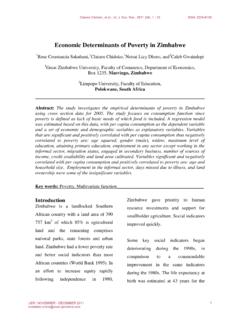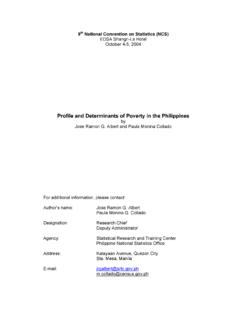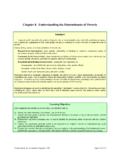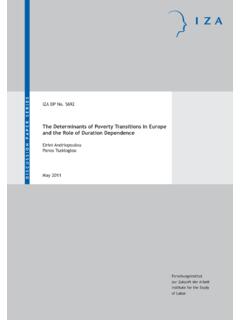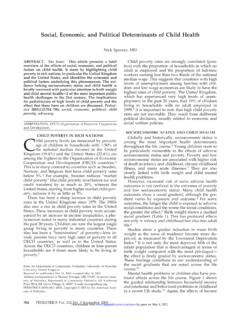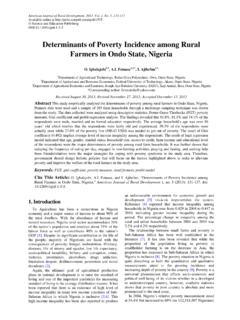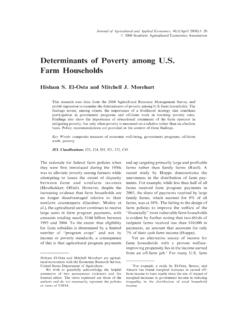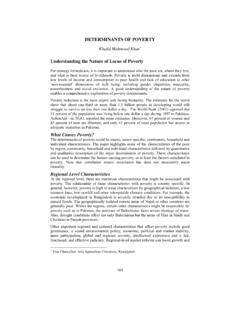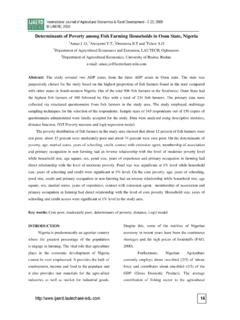Transcription of Understanding the Determinants of Poverty - World Bank
1 1458 SummaryA Poverty profile describes the pattern of Poverty , but is not principally concernedwith explaining the causes of Poverty . Yet, a satisfactory explanation of why somepeople are poor is essential if we are to be able to tackle the roots of Poverty . Among the key causes, or at least correlates, of Poverty are Region-level characteristics, which include vulnerability to flooding or typhoons,remoteness, quality of governance, and property rights and their enforcement Community-level characteristics,which include the availability of infrastructure(roads, water, electricity) and services (health, education), proximity to markets,and social relationships Household and individual characteristics,among the most important of which are Demographic, such as household size, age structure, dependency ratio, genderof head Economic, such as employment status, hours worked, property owned Social, such as health and nutritional status, education, analysis is commonly undertaken to identify the effects of each ofthese characteristics on income (or expenditure) per capita.
2 Attention is needed tochoose the independent variables carefully, to be sure that they are indeed exoge-nous. A number of more exotic techniques are now available for this purpose,including classification and regression tree (CART) models and multiple-adaptiveregression splines (MARS models).ChapterUnderstanding the Determinants of PovertyHaughton and Khandker8146 Regression techniques are good at identifying the immediate, proximate causesof Poverty , but are less successful at finding the deep causes; they can show that alack of education causes Poverty , but cannot so easily explain why some people lack ObjectivesAfter completing the chapter on Understanding the Determinants of Poverty , youshould be able to1. Identify the main immediate ( proximate ) causes of Classify the main causes of Poverty by characteristics related to the country orregion, the community, and the household and Explain how regression techniques may be used to identify the proximate causesof Poverty and their relative Explain why researchers generally prefer to use regressions to explain income (orexpenditure) per capita rather than whether an individual is Evaluate the assertion that the weakest part of Poverty analysis is the under-standing of Poverty s fundamental causes, and that this represents a missingmiddle that makes it difficult to define a successful antipoverty : What Causes Poverty ?
3 A Poverty profile describes the pattern of Poverty , but is not principally concernedwith explaining its causes. Yet, a satisfactory explanation of why some people arepoor is essential if we are to be able to tackle the roots of Poverty . This chapteraddresses the question of what causes may be due to national, sector-specific, community, household, orindividual characteristics. This chapter summarizes some of the characteristics ofthe poor by region, community, household, and individual characteristics andthen discusses how regression techniques can be used to determine the factors causing cautions are in order. First, it can be difficult to separate causation fromcorrelation. For instance, we know that poor people tend to have low levels of edu-cation; but are they poor because they have little education, or do they have littleeducation because they are poor? A statistical association alone is not enough toestablish causality, and additional information is likely to be required.
4 CHAPTER 8: Understanding the Determinants of Poverty8147 Second, most of the causes of Poverty that we identify in this chapter are imme-diate (or proximate ) causes, but not necessarily deep causes. For instance, sup-pose that we can demonstrate that low levels of education do indeed increase the riskof Poverty . This is interesting, but now begs the question of why some people havelow levels of education in the first place: Were the school fees too high? Was there noschool nearby? Was the quality of the education abysmal? Were their parents unsup-portive, or even hostile to education? Was there a concern that an educated womancould not find a husband?The weakest part of Poverty analysis what Howard White and David Booth(2003) call the missing middle is developing a clear Understanding of the funda-mental causes of Poverty in a way that leads naturally to an effective strategy to com-bat Poverty . Because there is no reason to believe that the root causes of Poverty arethe same everywhere, country-specific analysis is CharacteristicsAt the regional (or countrywide) level, numerous characteristics might be associatedwith Poverty .
5 The relationship of these characteristics with Poverty is country spe-cific. In general, however, Poverty is high in areas characterized by geographical iso-lation, a low resource base, low rainfall, and other inhospitable climatic example, many argue that economic development in Bangladesh is severelyretarded because of its susceptibility to annual floods; and Nghe An province innorth-central Vietnam is poor in part because it is regularly hit by typhoons, whichdestroy a significant part of the accumulated stock of capital. In many parts of theworld the remoteness of rural areas which lowers the prices farmers get for theirgoods and raises the prices they pay for purchases because of high transport costs is responsible for generating food insecurity among the poor. Inadequate publicservices, weak communications and infrastructure, as well as underdeveloped mar-kets, are dominant features of life in rural Cambodia, as in many other parts of theworld, and clearly contribute to Poverty .
6 Other important regional and national characteristics that affect Poverty includegood governance; a sound environmental policy; economic, political, and marketstability; mass participation; global and regional security; intellectual expression;and a fair, functional, and effective judiciary. Region-level market reforms can boostgrowth and help poor people, but they can also be a source of dislocation. The effectsof market reforms are complex, deeply linked to institutions and to political andsocial structures. The experience of transition, especially in countries of the formerSoviet Union, shows that market reforms in the absence of effective domestic insti-tutions can fail to deliver growth and Poverty reduction, at least initially. Inequality is also relevant to the analysis of Poverty ; its measurement is the sub-ject of chapter 6. Gender, ethnic, and racial inequality are both dimensions of andHaughton and Khandker8148causes of Poverty .
7 Social, economic, and ethnic divisions in regions are oftensources of weak or failed development. In the extreme, vicious cycles of social divi-sion and failed development erupt into internal conflict (within or across regions),as in the Balkans and Liberia, with devastating consequences for people. Community-Level CharacteristicsAs with regional characteristics, a variety of community-level characteristics may beassociated with Poverty for households in that community. At the community level,infrastructure is a major determinant of Poverty . Indicators of infrastructure devel-opment often used in econometric exercises include proximity to paved roads,availability of electricity, proximity to large markets, availability of schools andmedical clinics in the area, and distance to local administrative centers. Otherindicators of community-level characteristics include average human resourcedevelopment, access to employment, social mobility and representation, andland distribution.
8 Recently, there has been more emphasis on the importance of social networks andinstitutions, and social capital, which includes, for instance, the level of mutualtrust in the community (Putnam 1995). In addition to removing social barriers,effective efforts to reduce Poverty require complementary initiatives to build up andextend the social institutions of the poor. Social institutions refer to the kinship sys-tems, local organizations, and networks of the poor and can be thought of as differ-ent dimensions of social capital. Research on the roles of different types of socialnetworks in poor communities confirms their importance. An analysis of poor vil-lages in north India, for example, shows that social groups play an important role inprotecting the basic needs of poor people and in reducing risk (Kozel and Parker2000). A study of agricultural traders in Madagascar shows that social relationshipsare central; close relationships with other traders help lower transactions costs, whilelongstanding ties to creditors are vital sources of security and insurance (Fafchampsand Minten 1998).
9 How does social capital affect development? The narrowest view holds social cap-ital to be the social skills of an individual one s propensity for cooperative behav-ior, conflict resolution, tolerance, and the like. A more expansive meso viewassociates social capital with families and local community associations and theunderlying norms (trust, reciprocity) that facilitate coordination and cooperationfor mutual benefit. A macro view of social capital focuses on the social and politi-cal environment that shapes social structures and enables norms to develop. Thisenvironment includes formalized institutional relationships and structures, such asgovernment, the political regime, the rule of law, the court system, and civil andpolitical liberties. Institutions have an important effect on the rate and pattern ofeconomic development. CHAPTER 8: Understanding the Determinants of Poverty8149As the World Bank (2000, 129) writes, An integrating view of social capital rec-ognizes that micro, meso, and macro institutions coexist and have the potential tocomplement one another.
10 Macro institutions can provide an enabling environmentin which micro institutions develop and flourish. In turn, local associations help sus-tain regional and national institutions by giving them a measure of stability andlegitimacy and by holding them accountable for their actions. Social capital isclearly a complicated characteristic and often researchers find it difficult to identifyappropriate variables that measure social capital quantitatively. Household and Individual-Level CharacteristicsSome important household and individual characteristics would include the agestructure of household members, education, gender of the household head, and theextent of participation in the labor force. In recent times, other components underthis category have included domestic violence prevention and gender-based antidis-crimination policies. The following discussion organizes these characteristics intogroups and discusses them in greater detail.










